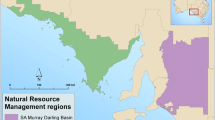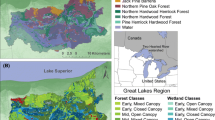Abstract
Land-use patterns are influenced by both top-down and bottom-up (local) factors, with their interactions varying in both space and time. This provides a major challenge to decision-making for sustainable multifunctional landscapes. A cross-scale scenario structure has been developed to integrate top-down and bottom-up context based upon the familiar IPCC Special Report on Emission Scenarios framework. Qualitative scenario storylines are converted into multiple quantified simulations of regional land-use change using a series of rules, with information translated across scales using a hierarchical land-use classification. Land-use parcels (fields) are used as key landscape reference units representing the local dimension of regional changes. Biophysical limitations on land use are represented through land capability classes (climate, soils and topography). Socio-economic factors are characterised in reference to global drivers, policy targets or local preferences. A flexible stochastic software tool (LandSFACTS) ensures spatiotemporal coherence of land-use allocation simulations consistent with scenario storylines. Scenario development is designed to be interactive, bridging ‘problem-focussed’ and ‘actor-focussed’ approaches. A case study is presented from NE Scotland, where plans to enhance multifunctionality through new woodland are evaluated against drivers of globalisation and climate change. Competing priorities, such as food security, mean that in some scenarios, a policy objective for woodland expansion to occur on farmland cannot be met. Woodland expansion would then have to occur on uncultivated upland areas. Scenario analysis has highlighted specific sensitivity to change in ‘marginal’ agricultural areas, with the varying influence of different top-down or bottom-up factors leading to divergent potential outcomes.







Similar content being viewed by others
References
Acosta L, Klein RJT, Reitsma P, Metzger MJ, Rounsevell MDA, Leemans R, Schröter D (in press) A spatially explicit scenario-driven model of adaptive capacity to global change in Europe. Glob Environ Chang
Alcamo J (2008) The SAS approach: combing qualitative and quantitative knowledge in environmental scenarios. In: Alcamo J (ed) Environmental futures: the practice of environmental scenario analysis. Elsevier, Amsterdam, pp 123–150
Audsley E, Pearn KR, Simota C, Cojocaru G, Koutsidou E, Rounsevell MDA, Trnka M, Alexandrov V (2006) What can scenario modelling tell us about future European scale agricultural land use, and what not? Environ Sci Policy 9:148–162
Bankes S (1993) Exploratory modelling for policy analysis. Oper Res 41:435–449
Baudry J, Thenail C (2004) Interaction between farming systems, riparian zones, and landscape patterns: a case study in western France. Landsc Urban Plan 67:121–129
Berger PA, Bolte JP (2004) Evaluating the impact of policy options on agricultural landscapes: an alternative-futures approach. Ecol Appl 14:342–354
Berkhout F, Hertin J, Jordan A (2002) Socio-economic futures in climate change impact assessment: using scenarios as ‘learning machines’. Glob Environ Chang Hum Policy Dims 12:83–95
Bibby JS, Heslop REF, Hartnup R (1988) Land capability classification for forestry in Britain. The Macaulay Land Use Research Institute, Aberdeen
Borjeson L, Hojer M, Dreborg KH, Ekvall T, Finnveden G (2006) Scenario types and techniques: towards a user’s guide. Futures 38:723–739
Bregt AK, Denneboom J, Gesink HJ, Vanranden Y (1991) Determination of rasterizing error: a case-study with the soil map of the Netherlands. Int J Geo Inf Syst 5:361–367
Brown I, Towers W, Rivington M, Black HIJ (2008) Influence of climate change on agricultural land-use potential: adapting and updating the land capability system for Scotland. Clim Res 37:43–57
Brown I, Poggio L, Gimona A, Castellazzi MS (2011) Climate change, drought risk and land capability for agriculture: implications for land-use policy in Scotland. Reg Environ Chang 11:503–518
Burton RJF, Wilson GA (2006) Injecting social psychology theory into conceptualisations of agricultural agency: towards a post-productivist farmer self-identity? J Rural Stud 22:95–115
Busch G (2006) Future European agricultural landscapes: what can we learn from existing quantitative land use scenario studies? Agric Ecosyst Environ 114:121–140
Castella J-C, Pheng Kam S, Dinh Quang D, Verburg PH, Thai Hoanh C (2007) Combining top-down and bottom-up modelling approaches of land use/cover change to support public policies: application to sustainable management of natural resources in northern Vietnam. Land Use Policy 24:531–545
Castellazzi MS, Wood GA, Burgess PJ, Morris J, Conrad KF, Perry JN (2008) A systematic representation of crop rotations. Agric Syst 97:26–33
Castellazzi MS, Brown I, Poggio L, Gimona A (2010a) Multi-scale modelling of ecosystem services: an iterative approach. In: Modelling for environment’s sake. International Congress on Environmental Modelling and Software. Ottawa, Canada. http://www.iemss.org/iemss2010/index.php?n=Main
Castellazzi MS, Matthews J, Angevin F, Sausse C, Wood GA, Burgess PJ, Brown I, Conrad KF, Perry JN (2010b) Simulation scenarios of spatio-temporal arrangement of crops at the landscape scale. Environ Mod Soft 25:1881–1889
de Nijs TCM, de Niet R, Crommentuijn L (2004) Constructing land-use maps of the Netherlands in 2030. J Environ Manag 72:35–42
Dendoncker N, van Wesemael B, Smith P, Lettens S, Roelandt C, Rounsevell M (2008) Assessing scale effects on modelled soil organic carbon contents as a result of land use change in Belgium. Soil Use Manag 24:8–18
Dockerty T, Lovett A, Sunnenberg G, Appleton K, Parry M (2005) Visualising the potential impacts of climate change on rural landscapes. Comput Environ Urban Syst 29:297–320
European Commission (2010) Environmental impacts of different crop rotations in the European Union. European Commission DG ENV
Fuller RM, Smith GM, Sanderson JM, Hill RA, Thomson AG (2002) The UK land cover map 2000: construction of a parcel-based vector map from satellite images. Cartogr J 39:15–25
Fürst C, König H, Pietzsch K, Ende H-P, Makeschin F (2010) Pimp your landscape: a generic approach for integrating regional stakeholder needs into land use planning. Ecol Soc 15(3):34
Gimona A, van der Horst D (2007) Mapping hotspots of multiple landscape functions: a case study on farmland afforestation in Scotland. Landsc Ecol 22:1255–1264
Girod B, Wiek A, Mieg H, Hulme M (2009) The evolution of the IPCC’s emissions scenarios. Environ Sci Policy 12:103–118
Hanson CE, Palutikof JP, Dlugolecki A, Giannakopoulos C (2006) Bridging the gap between science and the stakeholder: the case of climate change research. Clim Res 31:121–133
Holman IP, Rounsevell MDA, Shackley S, Harrison PA, Nicholls RJ, Berry PM, Audsley E (2005) A regional, multi-sectoral and integrated assessment of the impacts of climate and socio-economic change in the UK. Clim Chang 71:9–41
Houet T, Loveland TR, Hubert-Moy L, Gaucherel C, Napton D, Barnes C, Sayler K (2010) Exploring subtle land use and land cover changes: a framework for future landscape studies. Landsc Ecol 25:249–266
Kaufman S, Smith J (1999) Framing and reframing in land use change conflicts. J Arch Plan Res 16:164–180
Kienast F, Bolliger J, Potschin M, de Groot RS, Verburg PH, Heller I, Wascher D, Haines-Young R (2009) Assessing landscape functions with broad-scale environmental data: insights gained from a prototype development for Europe. Environ Manag 44:1099–1120
Lempert RJ, Popper SW, Bankes SC (2003) Shaping the next one hundred years: new methods for quantitative long-term policy analysis. RAND, Santa Monica
Mander U, Helming K, Wiggering H (2007) Multifunctional land use: meeting future demands for landscape goods and services. Springer, Berlin and Heidelberg
Matthews RB, Gilbert NG, Roach A, Polhill JG, Gotts NM (2007) Agent-based land-use models: a review of applications. Landsc Ecol 22:1447–1459
Max-Neef MA (2005) Foundations of transdisciplinarity. Ecol Econ 53:5–16
Metzger MJ, Rounsevell MDA, van den Heiligenberg HARM, Perez-Soba M, Soto Hardiman P (2010) How personal judgment influences scenario development: an example for future rural development in Europe. Ecol Soc 15(2):5
Nakicenovic N, Alcamo J, Davis G, de Vries B, Fenhann J, Gaffin S, Gregory K, Grubler A et al (2000) Special Report on Emissions Scenarios. Working Group III, Intergovernmental Panel on Climate Change (IPCC). Cambridge University Press, Cambridge
Nassauer JI (1995) Culture and changing landscape structure. Landsc Ecol 10:229–237
Paracchini ML, Pacini C, Jones MLM, Perez-Soba M (2009) An aggregation framework to link indicators associated with multifunctional land use to the stakeholder evaluation of policy options. Ecol Indic 11:71–80
Patt AG, van Vuuren DP, Berkhout F, Aaheim A, Hof AF, Isaac M, Mechler R (2010) Adaptation in integrated assessment modelling: where do we stand? Clim Chang 99:383–402
Reed M, Arblaster K, Bullock C, Burton R, Davies LS, Holden J, Hubacek K, May R, Mitchley J, Morris J, Nainggolan D, Potter C, Quinn CS, Swales V, Thorp S (2009) Using scenarios to explore UK upland futures. Policy Future Educ 41:619–630
Rounsevell MDA, Metzger MJ (2010) Developing qualitative scenario storylines for environmental change assessment. Wiley Interdiscip Rev Clim Chang 1:606–619
Rounsevell MDA, Reginster I, Araujo MB, Carter TR, Dendoncker N, Ewert F, House JI, Kankaanpaa S, Leemans R, Metzger MJ, Schmit C, Smith P, Tuck G (2006) A coherent set of future land use change scenarios for Europe. Agric Ecosyst Environ 114:57–68
Rounsevell MDA, Robinson DT, Murray-Rust D (2012) From actors to agents in socio-ecological systems models. Philos Trans R Soc B Biol Sci 367:259–269
Scottish Government (2011) Getting the best from our land: a land use strategy for Scotland. Edinburgh, UK
Slee B, Bergman H, Brown I, Huband S, McCracken D, Renwick A, Sutherland LA, Thomson S, Reed M (2009) Realising the potential contributions of Scotland’s rural land to delivering sustainable economic growth. Scottish Government Research Findings No 9. http://www.scotland.gov.uk/Publications/2009/12/04154104/0
Soliva R, Ronningen K, Bella I, Bezak P, Cooper T, Flo BE, Marty P, Potter C (2008) Envisioning upland futures: stakeholder responses to scenarios for Europe’s mountain landscapes. J Rural Stud 24:6–71
Sutherland LS, Barnes A, McCrum G, Blackstock K, Toma L (2011) Towards a cross-sectoral analysis of land use decision-making in Scotland. Landsc Urban Plan 100:1–10
UK National Ecosystem Assessment (2011) Synthesis of key findings. UNEP-WCMC, Cambridge
Valkering P, van der Brugge R, Offermans A, Rijkens-Klomp N (2011) Scenario analysis of perspective change to support climate adaptation: lessons from a pilot study on Dutch river management. Reg Environ Chang 11:229–241
van Notten PWF, Rotmans J, van Asselt MBA, Rothman DS (2003) An updated scenario typology. Futures 35:423–443
Veldkamp A, Lambin EF (2001) Predicting land-use change. Agric Ecosyst Environ 85:1–6
Verburg PH, Overmars KP (2009) Combining top-down and bottom-up dynamics in land use modeling: exploring the future of abandoned farmlands in Europe with the Dyna-CLUE model. Landsc Ecol 24:167–1181
Verburg PH, Schulp CJE, Witte N, Veldkamp A (2006) Downscaling of land use change scenarios to assess the dynamics of European landscapes. Agric Ecosyst Environ 114:39–56
Verburg PH, van de Steeg J, Veldkamp A, Willemen L (2009) From land cover change to land function dynamics: a major challenge to improve land characterization. J Environ Manag 90:327–1335
Volkery A, Ribeiro T, Henrichs T, Hoogeveen Y (2008) Your vision or my model? Lessons from participatory land use scenario development on a European scale. Syst Pract Action Res 21:459–477
Walz A, Lardelli C, Behrendt H, Grêt-Regamey A, Lundstrom C, Kytzia S, Bebi P (2007) Participatory scenario analysis for integrated regional modelling. Landsc Urban Plan 81:114–131
Wilkinson A, Eidinow E (2008) Evolving practices in environmental scenarios: a new scenario typology. Environ Res Lett 3. doi:10.1088/1748-9326/3/4/045017
Willemen L, Verburg PH, Hein L, van Mensvoort MEF (2008) Spatial characterization of landscape functions. Landsc Urban Plan 88:34–43
Wilson GA (2007) Multifunctional agriculture: a transition theory perspective. Oxford University Press, New York, pp 384
Zonneveld IS (1989) The land unit: a fundamental concept in landscape ecology, and its applications. Landsc Ecol 3:67–86
Zurek MB, Henrichs T (2007) Linking scenarios across geographical scales in international environmental assessments. Technol Forecast Soc Chang 74:1282–1295
Acknowledgments
This work was supported by the Scottish Government Strategic Research Programme.
Author information
Authors and Affiliations
Corresponding author
Rights and permissions
About this article
Cite this article
Brown, I., Castellazzi, M. Scenario analysis for regional decision-making on sustainable multifunctional land uses. Reg Environ Change 14, 1357–1371 (2014). https://doi.org/10.1007/s10113-013-0579-3
Received:
Accepted:
Published:
Issue Date:
DOI: https://doi.org/10.1007/s10113-013-0579-3




